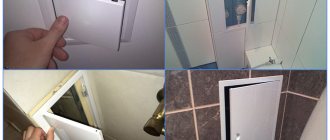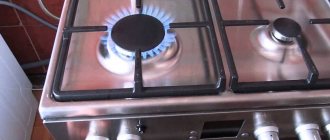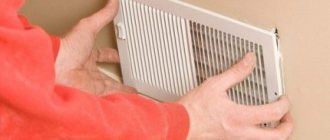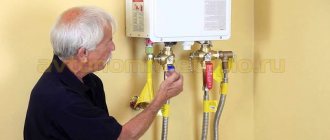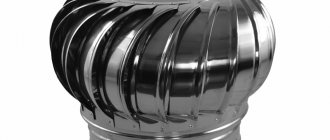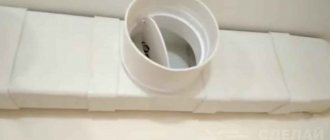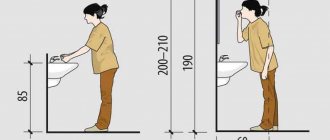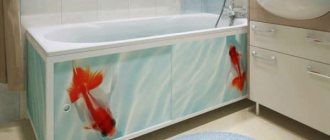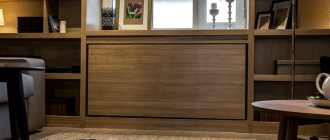Are you developing an interior design yourself, but don’t know if it’s possible to hang cabinets on a ventilation duct? On the one hand, you will be able to use the space of your home more rationally, but on the other hand, you absolutely don’t want to become a criminal because of a few square centimeters, right? So is this procedure legal and what should be done to avoid penalties?
We will help you find answers to your questions - in the article below we will tell you in detail whether it is possible to drill a box and hang cabinets and shelves on it, as well as change its design in any other way. We will also figure out what actions may be considered unlawful and what risks the violator bears.
Why is it better to build a house than to buy a ready-made one, especially if this house was built for sale.
Why is it better to build a house than to buy a ready-made one, especially if this house was built for sale.
The beginning of this story was absolutely ordinary.
In a newly purchased residential building, one heating radiator was not heating. The plumber who had been called before “improved” this radiator by removing the control valve and stupidly installing a plug in its place. Remember how Celentano repaired the car in “The Taming of the Shrew”, since then he has had many followers
Source: homemasters.ru
Is it possible to make a suspended ceiling if there is a built-in wardrobe?
In the case where the furniture is built up to the ceiling, a beam is mounted at a short distance from the guides. A profile for the tension fabric is attached to it. This results in an independent fastening. But if the cabinet is assembled before the mortgage is installed, it is more difficult to screw the molding on its side. There are two options here:
If the cabinet has a lid, there will be a gap of several centimeters between it and the ceiling. Then the beam is installed (depending on the size of the gap): close to the guides or directly into the gap.
Attention! The cross-section of the beam should not be more than 10 cm, otherwise it is impossible to insert doors under it.
To install the beam, metal corners are used. The profile for the film is attached to the lower surface of the beam. If the cabinet is not built into a niche, you need to make a walk around part of the perimeter. Then another installation order may be more convenient:
Peculiarities! If the beam is located between the lid and the ceiling, it can be masked with a strip of chipboard. Then the profile for the canvas is attached to the decorative strip.
An extension of the frame for the film is placed on the walls. Using a level, they ensure that the entire profile is at the same level. Then the PVC film is heated and stretched, and the gap remaining at the joint is masked with a decorative plug.
Attaching kitchen cabinets to a plasterboard wall
Designs with a combination of a metal frame and gypsum plasterboard have many advantages. However, due to the fragile structure, there is a problem with how to hang heavy objects, such as kitchen cabinets, on drywall.
This problem can still be solved if the material is mounted on a load-bearing wall using gypsum glue. But with frame structures everything is different; knowledge of the nuances of the material, and methods of fastening, of this or that element of furniture is required, and whether they can be used under specific circumstances.
Full contents of the material
Using profiles for other purposes
Each type of plasterboard profile has its own purpose. Sometimes a ceiling profile is used instead of a rack profile, this leads to the fact that the partition structure turns out to be fragile. In addition, this is associated with difficulties in work, since sheets cannot be attached to the ceiling profile on both sides. It is not recommended to bend profiles, cut or change their geometry.
This error is due to the fact that the use of ceiling profiles is allowed when covering walls or when creating boxes for shelves, a fireplace or a TV.
Ceiling profile partition.
Read more about the types of profiles for fastening drywall in the article “Profile for drywall: a brief educational program”
Methods for hanging cabinets on drywall
In principle, solving such an issue is not difficult if you know what methods were used in finishing and what to do in a particular case. There are three main ways to hang a kitchen cabinet on a plasterboard wall.
- Make mortgages at the stage of finishing the walls with sheets of material.
- Use anchors or dowels if the sheet is glued to a load-bearing wall.
Use special fasteners for drywall.
What are the subtleties of using such methods, and how to hang various cabinets on gypsum boards?
Use of mortgages
This method is only possible at the stage of finishing the walls with plasterboard. The main problem is that you need to plan the placement of all the elements in the kitchen, in particular the cabinets. Also, this method will not allow you to change the situation if the attachment points where the pieces of furniture are hung have not been prepared in advance.
Mortgages for cabinets
Mortgages are wooden beams mounted under the frame, which will then be covered with sheets of material. They are mounted using fasteners suitable for the wall material: dowels with self-tapping screws, anchor bolts, and others.
It is important that the wood is properly treated against moisture, and that the surface of the timber is at a minimum distance from the plasterboard sheathing.
After laying the timber, the wall is sheathed with gypsum boards, having previously made a diagram with their location. Fixing wall cabinets in such places will not pose any problems, using conventional fasteners in the form of self-tapping screws or anchor bolts.
When assembling a plasterboard partition, this method is practically the only correct one, and will allow you to attach kitchen cabinets without any problems.
Hanging a cabinet on glued plasterboard
Sometimes when finishing walls with plasterboard, the so-called frameless installation method can be used. In this case, the sheet is glued to the load-bearing surface using gypsum mounting adhesive and additional dowels.
In order to hang a kitchen cabinet in this situation, you can use crocodile-type dowels (if the walls are made of aerated concrete) or anchor bolts.
The work algorithm is as follows:
- Preliminary markings are made and fastening points are drilled.
- Dowels or anchors are installed.
- The cabinet is hung and securely fixed to the wall.
Using this method, it is important to choose the right fasteners in accordance with the wall material. If the load-bearing surfaces under the drywall are made of fragile blocks (gas and foam concrete), then standard plastic dowels or anchors will not work; they will simply fall out without providing reliable fixation.
Special fasteners for drywall
Most often, when finishing walls, a plasterboard structure is used, that is, a combination of a metal frame and sheathing. In such a situation, the sheet is located at a distance from the bearing surface. Standard dowels simply will not withstand the weight load. How to hang kitchen cabinets in this case?
If the load-bearing wall is located at a distance of up to 100 mm from the drywall, long anchor bolts can be used. But they must be securely screwed into the masonry by at least 40-50 mm. This is not always possible, so it is best to use special types of dowels that can be used to hang kitchen cabinets on drywall.
However, it is worth learning in more detail about each type of fastening, their maximum loads, and the objects that can be hung on them.
Butterfly dowel
Butterfly dowels are not ideal for attaching heavy kitchen cabinets. They can be used for hanging light elements, such as cornices, or decorative shelves that will not bear heavy loads.
Butterfly dowel for drywall
The fastener consists of a plastic dowel and a self-tapping screw. At the moment the screw is screwed in, it spreads the “wing” ends, which rest against the drywall on the back side, distributing the load.
However, it is important to know two main nuances of this type of fastening; it cannot be used with small rear space and with a finishing thickness of less than 10 mm.
Driva
This type of fastener can be used to hang kitchen shelves, or hang a light cabinet on drywall.
Source: gipsokarton-blog.ru
Hanging height
Consider the distance from the countertop to the bottom of the cabinet. Minimum – 45 cm, average – 90 cm. At a height of 110 cm, hang only one shelf.
You can also use the formula:
H=h1+h2+h3-45mm, where the letters are the height:
- H – from the lower stop (table top, floor) to the bar;
- h1 – furniture above which the box is hung;
- h2 – kitchen apron;
- h3 – wall cabinets.
Subtract 45 mm from the resulting sum of all heights - this is the standard indicator of suspension shrinkage.
Focus on the height of people who most often use things from the closet. The optimal distance would be when a person reaches with an outstretched arm to the top shelf and takes the item without the risk of dropping it. But also leave enough space above the countertop.
Standard parameters of a kitchen set
Expert opinion
Bashir Rabadanov
Technologist at the furniture company Woodband
If it is necessary to hang over tall equipment, place the lower part of the cabinet in close proximity to their upper limits, almost close to the ceiling. This applies to refrigerators and ovens.
Find out more about hanging heights for kitchen furniture.
How to hang a cabinet on a plasterboard wall
In recent years, drywall has become very popular. This material is used for cladding rooms and for finishing walls. Plasterboard sheets quickly level any surface, make all defects invisible, and allow designers to realize all sorts of fantasies. However, among the many positive properties of this material, there is one serious drawback. Drywall is highly fragile, so many people think that hanging a cabinet on a plasterboard wall is an almost impossible task.
Masking the box using simple materials
The following materials can be used for camouflage.
- Slate. Suitable for modern design. Helps create a key focal point in the room.
- Mirrors. Relevant for a small kitchen. The mirror surface allows you to visually increase the dimensions.
- Mosaic. Allows you to turn a problematic design into an attractive highlight of the kitchen. By choosing metal mosaic details, you can fit it into a loft or hi-tech style.
- Tile. Allows you to create an attractive appearance. A combination of light and dark squares is especially preferable.
It is prohibited to dismantle the box, because any damage to the ventilation system can lead to serious consequences.
In some rooms, it is possible to reduce the ventilation duct, but to do this, you must first obtain a diagram of the home’s ventilation system from the housing organization, and then seek help from specialists.
Basic rules for attaching cabinets to drywall
If you follow a certain technology, the cabinet can be hung on a plasterboard wall. To carry out such work, you must follow certain rules:
- All hardware, brackets and other fastening materials must be of the highest quality.
- To avoid making mistakes, measurements must be taken before starting the operation. They will help you avoid mistakes that will require you to redo the entire job.
- To avoid accidental injury, the cabinet must be secured in accordance with safety requirements. You must wear gloves on your hands and wear glasses on your eyes.
Installation of the filling frame
The sequence of installing the frame is shown in the mini-animation. The numbers indicate the order of installation of laminated chipboard parts:
Metal corners for attaching the right and left walls of the frame to the main wall are indicated by gray squares. When we fix the frame with screws to the main wall, the squares will turn red.
Now let's look at each stage in more detail.
Let me remind you that all the actions listed below are performed with the parts of the frame filling the built-in wardrobe made of laminated chipboard, which we previously assembled on the floor. That is, all the holes for confirmations have already been drilled, the shelves are adjusted and numbered.
1 Carefully lift the left wall of the laminated chipboard frame from the floor with the top shelf pre-screwed to it.
We move the structure to the installation site, lay the left edge of the shelf on the already screwed corners on the left wall. In this case, we place the laminated chipboard wall almost vertically, but with a slight slope towards the left wall of the room. This is necessary for its minimal stability.
We move the laminated chipboard wall with the shelf close to the back wall, holding the shelf so that it does not fly off the corners.
Carefully “grab” the shelf with a screw to one of the two plastic corners. We do not tighten the screw all the way. Level the wall to a vertical position (see photo).
2 We install the lower left shelf - we fix it only to the wall with confirmations.
The left side of the shelf lies freely on the corners screwed to the wall.
We check the horizontality of the left shelves and the verticality of the wall using a building level.
After making sure that the shelves lie horizontally and the wall is absolutely vertical, mark with a pencil on the back wall through the holes in the metal corners the places where we will drill the wall for dowels (3 pieces).
To drill holes for dowels in the main wall, disassemble the structure in the reverse order.
We drill three holes in the back wall of the room according to our marks for a 6x50 mm dowel. Insert dowels into all three holes.
We install the left wall again, screw it to the wall with screws through the metal corners - not all the way, so that the wall moves a little.
We install the upper and lower left shelves - fasten them to the wall with confirmations, tighten them until they stop. The left sides of the shelves are just lying on the corners for now.
3, 4 We hang the narrow upper shelf of the right section on one confirmation on the left wall (see photo).
We carefully bring the right wall to the installation site and rest it against the hanging shelf, “grabbing” it with a confirmation (see photo).
We turn the shelf to its normal (horizontal) position, secure it with the remaining two confirmations on the right and left walls (see photo).
We install the lowest (narrow) shelf in the right section. We tighten the confirmations until they stop.
Thus, we obtained a fairly rigid frame that can be moved on the floor within small limits. We will move it with the goal of “squeezing” it into the corner of the room as tightly as possible.
It is necessary to press the walls of the frame as close as possible to the rear main wall of the room, and so that all the shelves on the left (not yet secured to the plastic corners) rest as tightly as possible against the left main wall.
After “pressing” the frame, we check the verticality of both walls. If necessary, we align them.
We take measurements to install the floor plinth inside the frame.
We mark on the rear main wall the places where we will drill holes in the wall for dowels for fastening with metal corners of the right wall (see photo).
We mark the installation locations of the plastic corners for attaching the right wall to the ceiling (on the block) - we apply the markings both on the wall and on the block (see photo).
We mark the places where the metal corners are attached to the floor (see photo).
We remove the shelves of the right section and the right wall in reverse order.
We cut the floor plinth, drill holes in the main walls for dowels to install the plinth. We drive in the dowels.
Using a hammer drill, we drill 4 holes in the rear main wall and insert 6x50 mm dowels into them. Reassembling the right section. We finally level the cabinet frame and “tightly” fasten the walls to the main wall with suitable screws through the metal corners.
We fasten the shelves of the left section to the corners on the left wall with 4x16 mm screws.
7, 8 We install the remaining shelves in the right section and secure them with confirmations.
All shelves are now installed. We check their horizontality.
Pay special attention to the horizontal position of the lowest (narrow) shelf in the right section. This shelf is located under the bottom drawer, and we will use it to align the fronts of all drawers.
Check the verticality of the walls.
We screw the corners on the floor and ceiling.
We move the left decorative strip close to the shelves of the left section, check its verticality, and screw in the screws until they stop.
We install the floor plinth.
We received a fully assembled, well-stretched frame.
Source
Ways to hang a cabinet on a drywall wall
First of all, you need to determine the weight of the cabinet. Taking into account the mass, the type of fastening is determined, as well as various methods for fixing heavy furniture.
Mortgage beam
These parts are pre-installed into the plasterboard wall, with a certain step, when assembling the frame. The main advantage of this method is the ability to create a strong fastening. In principle, a mortgage is understood as a frame lintel, which includes several beams and pieces of profile. The work is performed in the following sequence:
- A well-dried timber of the required size is selected. To adjust the height of the fastener, to accurately hit the embedded screw with a self-tapping screw, it is necessary that the width of the beam exceeds 10 cm.
- The slats (beams) are cut into pieces of a certain length.
- They are nailed to the wall, maintaining horizontality between the fixed profile in 2-3 places.
- The mounting height is selected taking into account the axis, which should be located at the same level as the cabinet mounting points.
- Having installed the mortgages, the area where they are located is measured and all dimensions are recorded. Then the walls are covered with plasterboard.
- Before fastening furniture, a certain distance is set aside from the floor surface and a horizontal line is drawn on the wall.
- The product is raised to the desired height, and the hinges are attached with self-tapping screws.
We use horizontal tires
Wall cabinets are always equipped with special tires. They are a rigid bar with bends.
At the location of the cabinet, the rail is tightly attached to the wall. It is very important to create a reliable fastening, because the cabinet will only be held by hooks and will not touch the wall surface. The tire is attached to the profile with long self-tapping screws through sheets of drywall. Where there is no profile, fastening is carried out with dowels.
Helpful advice! Use a strong magnet to locate the metal profile located under the plasterboard sheathing.
Fastening with dowels
Two screw-in dowels can withstand a pressure of 60 kg. They will hold the furniture firmly. A screwdriver is used to screw in the hardware. When screwing, plastic fasteners sometimes break. To avoid such damage, professionals advise first making a hole (diameter 5-6 mm). Only then screw in the dowel. Self-tapping screws are used to secure the cabinet to the plastic dowel.
Anchor expansion fastener
It is much more difficult to create such a mount, but it is many times more reliable. The anchor, located behind the drywall, is strongly compressed when tightened, then diverges in different directions. This method can be used to attach not only wall cabinets. The anchor can easily support 50 kg. It can be used to mount a ceiling chandelier. Anchor fasteners are divided into several groups:
- "Molly". The kit includes a screw and a metal dowel.
- "Butterfly". Has a plastic core. Comes with a screw.
To secure the furniture, a hole is drilled at the indicated points along the diameter of the anchor. The fasteners are installed, but not fully tightened. The edge at the end protects it from falling. A screw is screwed through the mounting loops. When tightening, no great effort is required. If you overtighten the screw, it may turn and you will have to change the fastening.
Useful drilling tools
A jack of all trades always needs certain tools to work in a private house, on a summer cottage, in an apartment, or when building his own house. Many of them are not even worth purchasing if they do not require constant use. For example, for drilling, there are many different attachments that will greatly increase the functions of your drill and significantly expand them.
Let's look at some devices for auxiliary potential.
To obtain precise holes of significant diameter in different workpieces, a device such as a drilling and milling attachment will help to carry out individual milling work.
Make a milling machine out of a drill.
The next device worth mentioning is very expensive, but has the highest versatility. You will sharpen all the tools that you have on the farm, be it knives, shovels, axes, hoes, various drills, effortlessly with the universal sharpening device.
When purchasing drill attachments, be sure to check their compatibility.
Holder with clamp. With its help, you can fix the drill anywhere, use it with various kinds of devices, use it as a mini-lathe, sharpening, milling or grinding and polishing machine.
The drill holder allows you to quickly secure the drill.
All kinds of attachments are also designed for drills. These can be stops that limit the depth of drilling, platforms with which you can drill at a certain angle or perpendicularly. There are nozzles that are adapters and extensions of different designs: offset, angled, flexible.
The angle drill adapter is designed for hand and electric drills.
Metal cutting attachments turn your drill into a one-of-a-kind tool. Some resemble sheet metal shears, while others have a different feature, such as roller shears. The nozzle, called the “Cricket,” seems to cut through the metal.
The main advantage is that they do not damage the polymer coating of the metal.
There are also other attachments designed for monotype work.
- For installing aluminum rivets. There are types for both the same size and those with interchangeable bushings for different calibers.
- Tape-shaped attachment for self-tapping screws. With its help, you will significantly save time when working with plasterboard partitions or when you need to secure other materials with self-tapping screws.
- A belt sanding attachment will completely replace a sanding machine, and it will be much cheaper in cost.
- An attachment with which you can turn your drill into a hammer drill will not be superfluous.
- Using the corner pruner attachment, you can cut various cables, as well as tree branches.
- Using a variety of attachments, the drill will replace your jigsaw, circular saw, pump, and you can polish surfaces and sharpen drills.
- There are unusual attachments.
Whatever attachments we use, the main thing is that the work is enjoyable.
Rules for choosing the decoration of the ceiling surface for the kitchen
On the market, manufacturers offer slatted, panel, tensioned options, but professionals recommend a simple plastered look.
What is the reason for this choice:
- the classic version has a white and smooth surface, has aesthetic characteristics, and is suitable for any modern interior;
- this material is safe from an environmental point of view;
- the absence of additional hanging systems will visually expand the room;
Plastered ceiling
Among the disadvantages of a plastered ceiling covering, we note:
- complexity of creation, the need to obtain a perfectly smooth surface;
- labor intensity of work (time and resources), preliminary cleaning of the ceiling covering, its puttying, whitewashing (painting);
It is much easier to level the surface by using moisture-resistant ceiling wallpaper intended for painting.
Kitchen facades to the ceiling and ventilation grille - how to solve
Kitchen facades up to the ceiling and ventilation grilles – how to solve?
Recommended Posts
Join the discussion
You can respond now and register later. If you already have an account, please log in to reply as yourself.
Recently viewed by 0 users
No registered user is viewing this page.
20+ Quick Kitchen Care Tips
Kitchen interior in Provence style with a mint set and a patchwork apron
Modern kitchen wall design: 10 ideas you never thought of
Characteristics of the ceiling surface based on PVC tiles
Among the materials in demand when decorating a kitchen ceiling are polystyrene foam tiles. The advantages of this decorative material include:
- lack of special skills for gluing polymer ceiling tiles;
- there is no need to specially pre-prepare the ceiling surface for PVC tiles;
- low cost of work performed;
- minimal time spent on gluing PVC tiles;
- the ability to hide all imperfections (cracks, potholes, protrusions) of the ceiling covering under PVC tiles;
- There is no need to call craftsmen; you can make such a ceiling on your own.
PVC tiles - easy and fast
Among the minor disadvantages of such a coating, we highlight the external characteristics of the ceiling. PVC tiles can hardly be called a fashionable modern finishing material, so this option will not fit into the “modern” style; the tiles are only suitable for the “retro” option.
Reasons why a mine may stop working
A typical air duct problem is air flowing backwards. It all depends on the features of the system used. For example, all shafts in an apartment direct waste streams to a common channel.
If an individual channel in one of the apartments fails, this will not affect the performance of the entire system. But if there are several such apartments, then the air flow simply will not be able to push itself further, and accordingly, it will go down. The last floors will draw in the exhaust air. Usually in this case they decide to bring their channel directly to the roof. The culprit for air exchange problems in individual apartments may be plastic double-glazed windows or the lack of a gap between the floors.

